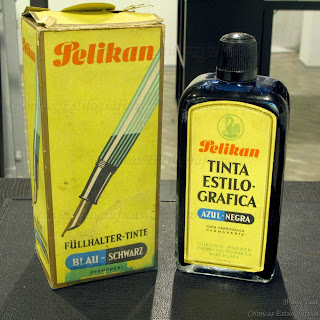Initially, it was marketed in 14 different colors, and pen body and feed were colored accordingly. The price was JPY 300 (plus taxes).
Its main inconvenient features were, first, the inability to use converters—the barrel is too short—and the insecure posted configuration. The cap could indeed be posted, and in fact, posting was required for the pen to be comfortable for writing, but one could never be sure how secure was the cap on the barrel.
Those Pilot Petit-1 are now on their second generation, and Pilot has changed some details.
Pilot Petit is now a line of three different pens: a fountain pen –Petit-1--, a signature pen –a kind of marker, the Petit-2--, and a brush (fude) pen by the name of Petit-3. All three use the same type of ink cartridge.
 The three Petit pens: The fountain pen Petit-1, the signature pen Petit-2, and the brush pen Petit-3. All three use the same type of cartridge and of ink.
The three Petit pens: The fountain pen Petit-1, the signature pen Petit-2, and the brush pen Petit-3. All three use the same type of cartridge and of ink.The eight inks available for the Petit line of pens.
The number of inks has been reduced to eight, and some of the most interesting colors have disappeared—that is the case of a dark green and a dark brown.
The five different models of the Petit-1 fountain pen.
The fountain pen also shows some changes. This second generation is not colored following the ink selection. Instead, there are only five different variations in yellow, violet, pink-purple, whitish and transparent. The feeds are now transparent and they become colored by the ink. Contrary to the previous practice, now the pens are not inked.
The transparent feed.
Finally, the pen barrel has also changed. Now it has four very subtle notches where the cap fits securely when posted.
The barrel has four notches to secure the posted cap.
The price of this pen is now JPY 200 (plus taxes) and the three-cartridge pack costs JPY 100. This second generation might not be so attractive as the first, but its performance has increased and its price is lower.
(Pilot Petit-1, 2nd generation – Pilot Appuru Gurîn, Apple Green)
Bruno Taut
September 2nd, 2011
[labels: Pilot]
Bruno Taut
September 2nd, 2011
[labels: Pilot]

















































